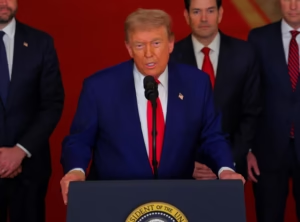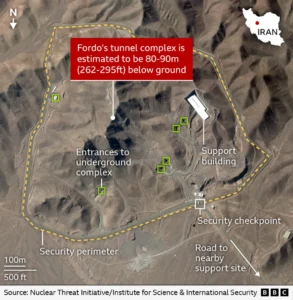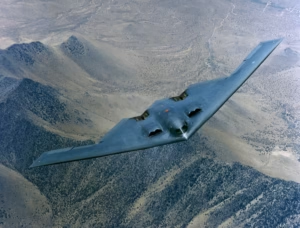United States President, Donald Trump on June 21, 2025 publicly announced that the United States had bombed and destroyed three major nuclear enrichment sites in Iran — Fordow, Natanz, and Esfahan, marking a dramatic escalation in tensions with Tehran. He declared the strikes a success in halting Iran’s nuclear threat.
Trump emphasized close cooperation with Israeli Prime Minister Benjamin Netanyahu in coordinating the strikes, describing their teamwork as unprecedented. Netanyahu praised Trump’s bold move, calling it historically significant and transformative for the region.
Trump issued a stern warning to Iran against any retaliatory actions, threatening even more devastating future strikes if Iran did not pursue peace. He described the targets already hit as the most difficult and lethal.

Meanwhile, Iranian state media confirmed attacks on the Fordow site and reported explosions near Esfahan. Air defenses were reportedly activated. Despite the damage, Iran’s Atomic Energy Organization vowed to continue its nuclear program, portraying it as a matter of national pride and martyrdom, vowing not to halt its development in the face of foreign aggression.
The US involvement followed over a week of Israeli military operations aimed at degrading Iran’s air defenses and missile systems, paving the way for targeting its fortified nuclear infrastructure.
US stealth bombers, particularly B-2s stationed in Guam, were reportedly involved in the strikes, utilizing advanced bunker-buster bombs capable of destroying underground facilities like those at Fordow.
Top Republicans rallied behind Trump, claiming the strikes showcased American resolve. Speaker Mike Johnson emphasized that Trump had offered diplomacy first but was left with no choice after Iran’s refusal.
Prominent Democrats, especially Senator Bernie Sanders, harshly criticized the strikes as unconstitutional, citing Trump’s failure to seek Congressional approval. Sanders warned of the dangers of unilateral military action.
UN Secretary-General António Guterres condemned the attack, warning of a dangerous regional escalation. He urged restraint and emphasized that diplomacy—not war—was the only viable path to peace.


Prior to the strikes, B-2 bombers had been quietly deployed to Guam, signalling preparation for a potential strike. A US official confirmed their use in the attack on Iranian nuclear facilities.
Iran continues to assert that its nuclear program is peaceful in nature. Israel, however, maintains that Tehran’s real goal is to acquire nuclear weapons and has acted pre-emptively to stop it.
The decision to engage militarily marks a major risk for Trump, who had campaigned on avoiding entanglements in foreign wars. The move contradicts his earlier foreign policy stance against interventionism.
Reports indicate significant division within Trump’s team. Vice President JD Vance privately expressed concern that Israel was drawing the US into war, and intelligence officials, including Tulsi Gabbard, doubted Iran’s intent to build nuclear weapons.
Iran’s supreme leader, Ayatollah Ali Khamenei, warned that any US attacks would lead to “irreparable damage,” and the foreign ministry called American involvement a path toward full-scale regional war. Despite this, the Trump administration proceeded, betting on military pressure to force Iran to the negotiating table.